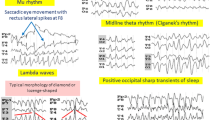Abstract
It is known that primary (swallow-induced) esophageal contractions are abnormal in alcoholics. Data concerning acid-induced esophageal contractions, which appear to be important in cleansing refluxed acid from the esophagus, are lacking. To determine whether acid-induced esophageal contractions are also affected by chronic ethanol exposure, we studied secondary (acid or saline-induced) esophageal motor events in 19 male alcoholics [6 actively drinking (ADA), 13 withdrawing (WA)]. Esophageal motility was performed in response to wet swallows (5 ml of water) and to intraesophageal injection of 5 ml of 0.1 N HCl (0.1 N) or saline. Lower esophageal sphincter pressure (LESP), amplitude (ECA), duration (ECD), and velocity (ECV) of esophageal contractions in response to swallowing and injection of acid or saline were similar in controls and alcoholics. There were more simultaneous and double-peaked contractions in response to acid and saline than to swallows in both alcoholics and controls. However, there was no difference between HCl- and NaCl-induced contractions. ECA in alcoholics was significantly higher than in controls. ECD in alcoholics was significantly more prolonged than in controls. There was no significant different between alcoholics and controls in ECV, LESP, or LES relaxation. These data indicate that similar to primary esophageal contractions, secondary esophageal contractions are also abnormal in both actively drinking and withdrawing alcoholics.
Similar content being viewed by others
References
Winship DH, Caflisch CR, Zboralske FF, Hogan WJ: Deterioration of esophageal peristalsis in patients with alcoholic neuropathy. Gastroenterology 55:173–178, 1968
Silver LS, Worner TM, Korsten MA: Esophageal function in chronic alcoholics. Am J Gastroenterol 81:423–427, 1986
Keshavarzian A, Iber FL, Ferguson Y: Esophageal manometry and radionuclide emptying in chronic alcoholics. Gastroenterology 92:651–657, 1987
Keshavarzian A, Polepalle C, Iber FL, Durkin M: Esophageal motor disorder in alcoholics: Result of alcoholism or withdrawal. Alcohol Clin Exp Res 14:561–567, 1990
Burbige EJ, Lewis DR, Halsted CH: Alcohol and the gastrointestinal tract. Med Clin North Am 68:77–89, 1984
Wienbeck M, Bergs W: Esophageal lesions in the alcoholic. Clin Gastroenterol 10:375–388, 1981
Diamant NE: Physiology of the esophagus.In Gastrointestinal Disease. 4th ed. MH Sleisenger, JS Fordtran (eds). Philadelphia, WB Saunders, 1989, pp 548–559
Reid RW, DElcarlo F: Determination of alcohol in whole blood and tissue by pyrolysis gas chromatography. Clin Chem 19:662, 1973
Schuchmann JA: Sural nerve conduction: a standardization technique. Arch Physical Med Rehab 58:166–168, 1973
Kimura J: Electrodiagnosis in Diseases of Nerve and Muscle. Philadelphia, Davis, 1983, pp 130–133
Christensen J: The control of esophageal movements. Clin Gastroenterol 5:15–27, 1976
Goyal RK, Rattan S: Neurohumoral, hormonal and drug receptors for the lower esophageal sphincter. Gastroenterology 74:598–619, 1978
Reynolds JC, Ouyand A, Cohen S: Lower esophageal sphincter reflex involving substance P. Am J Physiol 246:G346-G354, 1984
Reynolds JC, Dukehardt MR, Ouyand A, Cohen S: Interaction of bombesin and substance P at the feline lower esophageal sphincter. J Clin Invest 77:436–440, 1986
Inove F, Frank GB: Effect of ethyl alcohol on excitability and on neuromuscular transmission in frog skeletal muscle. Br J Pharmacol 30:186–193, 1967
Sonano S, Miyazaki E: Effects of ethanol and acetone on action potential and inhibitory potential of guinea pig taenia coli. Nature 221:380–381, 1969
Toman JP, Javis JP: The effects of drugs upon the electrical activity of the brain. Pharmacol Rev 1:425–492, 1949
Kalant H: Some recent physiological and biochemical investigations on alcohol and alcoholism. J Stud Alcohol 23:52–93, 1962
Hunt WA: Neurotransmitter function in the basal ganglia after acute and chronic ethanol treatment. Fed Proc 40:2077–2081, 1981
Ritzmann RF, Tabakoff B: Effects of nutrition, alcohol and age on the brain.In Nutrition in Gerontology. J Ord, D Arman, R Alfin-Slater (eds). New York, Raven Press, 1984, pp 257–278
Topel H: Biochemical basis of alcoholism: Statements and hypotheses of present research. Alcohol 2:711–788, 1985
Tabakoff B, Munoz-Marcus M, Fields J: Chronic ethanol feeding produces an increase in muscarinic cholinergic receptors in mouse brain. Life Sci 25:2173–2180, 1979
Author information
Authors and Affiliations
Rights and permissions
About this article
Cite this article
Keshavarzian, A., Polepalle, C., Iber, F.L. et al. Secondary esophageal contractions are abnormal in chronic alcoholics. Digest Dis Sci 37, 517–522 (1992). https://doi.org/10.1007/BF01307573
Received:
Revised:
Accepted:
Issue Date:
DOI: https://doi.org/10.1007/BF01307573




